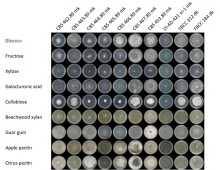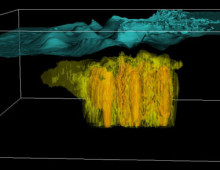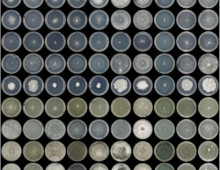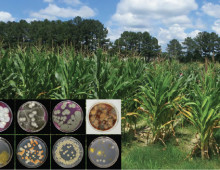This project focuses on the diversity of isolates of the white rot basidiomycete Dichomitus squalens.
Examining a predominant Deepwater Horizon microbe
Single-cell genomics unravels a microbial species’ role in breaking down hydrocarbons. The Science: Researchers sequenced and analyzed a single cell of Colwellia bacteria to understand why these microbes were predominant in the Gulf of Mexico after the Deepwater Horizon oil spill. The Impact: Understanding the characteristics of the Colwellia bacteria furthers the researchers understanding of…
DOE JGI, EMSL Announce 2015 Collaborative Science Projects
Combining complementary resources for greater scientific understanding. The U.S. Department of Energy Joint Genome Institute (DOE JGI) and the Environmental Molecular Sciences Laboratory (EMSL) have accepted 12 projects submitted during the 2014 call for Collaborative Science Initiative proposals. The collaborative call represents a unique opportunity for researchers to combine the power of genomics and molecular characterization in…
Microbial Interactions in Agricultural Soils
Growing crops as bioenergy feedstocks requires researchers to focus on soil management and better understand the soil carbon cycle. However, the data on soil microbiology is still limited, preventing researchers from incorporating this information into biogeochemical models. To this end, the project focuses on the microbial interactions in agricultural soils, with the goal of identifying…
FECB: A Functional Encyclopedia of Cyanobacteria
The DOE JGI’s Genomic Encyclopedia of Bacteria and Archaea (GEBA) project has been filling the genomic gaps in the prokaryotic tree of life. One offshoot of the project, called GEBA-Cyano, focuses on improving the understanding of the genetic basis of cyanobacterial ecophysiology. Cyanobacteria are eminently DOE mission-relevant organisms, playing key roles in global carbon and…
Fungal Mutations for Biofuels Production
Filamentous fungi such as Trichoderma reesei and various Aspergillus species are the workhorses of the biotechnology industry, annually producing a vast array of products that includes billions of dollars in enzymes. These enzymes play key roles in biofuels production because they can break down plant biomass into fermentable sugars. The demand for fungal protein expression…
Ascomycete Fungi and the Carbon Cycle
Basidiomycetes and Ascomycetes are key organisms in the degradation of wood, plant and animal material. Ascomycetes are less capable of rapid wood decay than basidiomycetes, but they are considered more important degraders of plant biomass in compromised environmental systems. As factors such as increasing soil temperatures impact the various processes that regulate life on the…
Microbial Blueprint of a California Grassland
The Intergovernmental Panel on Climate Change and the Department of Energy have emphasized the need to better understand and predict how changing climate conditions might impact carbon cycling and carbon sequestration in ecosystems. Grasslands and rangelands account for about 40 percent to 70 percent of terrestrial ecosystems, so understanding the interactions between common grass species…
Maize and Their Endophyte Communities
Maize is a major component of diets worldwide. It is also a major commodity crop in the U.S. that is used as feedstock for biofuels, as animal feed, and as a source of raw materials for the production of refined industrial products. Several diseases affect maize production globally and regionally, reducing both biomass yield and…
Microbial Communities and Their Functions in Peatlands
While peatland ecosystems represent only up to five percent of the land surface, they sequester up to a third of soil organic carbon. Despite this important position in the biosphere much less is known about microbial communities and their functions in peatlands compared to most other terrestrial and ocean habitats. The net effects of increased…





